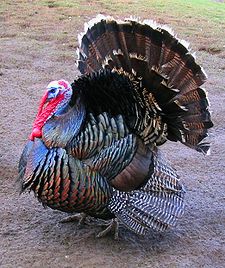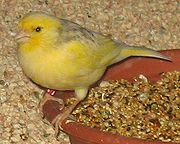
ATCvet code QI01
Encyclopedia
QI01AA Inactivated viral vaccines
- QI01AA01 Avian infectious bursal (gumboro) diseaseInfectious Bursal DiseaseInfectious bursal disease is a highly contagious disease of young chickens caused by infectious bursal disease virus , characterized by immunosuppression and mortality generally at 3 to 6 weeks of age. The disease was first discovered in Gumboro, Delaware in 1962...
virus - QI01AA02 Newcastle diseaseNewcastle diseaseNewcastle disease is a contagious bird disease affecting many domestic and wild avian species. First found in Newcastle, United Kingdom in 1926, then by Burnet in 1943 in Australia in connection with laboratory infection where the virus was isolated from a ocular discharge of a patient to show the...
virus/paramyxovirusParamyxovirusParamyxoviruses are viruses of the Paramyxoviridae family of the Mononegavirales order; they are negative-sense single-stranded RNA viruses responsible for a number of human and animal diseases.-Genera:*Subfamily Paramyxovirinae**Genus Avulavirus Paramyxoviruses (from Greek para-, beyond, -myxo-,... - QI01AA03 Avian infectious bronchitisAvian infectious bronchitisAvian infectious bronchitis is an acute and highly contagious respiratory disease of chickens. The disease is caused by avian infectious bronchitis virus , a coronavirus, and characterized by respiratory signs including gasping, coughing, sneezing, tracheal rales, and nasal discharge. In young...
virus - QI01AA04 Avian reovirusAvian reovirusThe avian reovirus causes an important poultry disease.Vaccines are available ....
- QI01AA05 Avian adenovirusAvian adenovirusAlso known as: Haemorrhagic Enteritis — HE — Egg Drop Syndrome — EDS — Quail Bronchitis — QB — Pheasant Marble Spleen Disease — MSD — Inclusion Body Hepatitis — IBH-Introduction:...
- QI01AA06 Avian infectious bronchitis virus + avian infectious bursal (gumboro) disease virus + newcastle disease virus/paramyxovirus + avian rhinotracheitis virus
- QI01AA07 Avian infectious bronchitis virus + avian infectious bursal (gumboro) disease virus + newcastle disease virus/paramyxovirus + avian rhinotracheitis virus + avian adenovirus
- QI01AA08 Avian infectious bronchitis virus + avian infectious bursal (gumboro) disease virus + newcastle disease virus/paramyxovirus
- QI01AA09 Newcastle disease virus/paramyxovirus + avian infectious bursal (gumboro) disease virus + avian adenovirus
- QI01AA10 Avian infectious bronchitis virus + newcastle disease virus/paramyxovirus
- QI01AA11 Avian infectious bursal (gumboro) disease virus + newcastle disease virus/paramyxovirus
- QI01AA12 Newcastle disease virus/paramyxovirus + avian adenovirus + avian adenovirus
- QI01AA13 Newcastle disease virus/paramyxovirus + avian infectious bronchitis virus + avian adenovirus
- QI01AA14 Avian infectious bronchitis virus + avian adenovirus
- QI01AA15 Avian infectious bronchitis virus + avian infectious bursal (gumboro) disease virus
- QI01AA16 Avian infectious bronchitis virus + avian infectious bursal (gumboro) disease virus + newcastle disease virus/paramyxovirus + avian reovirus
- QI01AA17 Avian rhinotracheitis virus
- QI01AA18 Avian infectious bronchitis virus + newcastle disease virus/paramyxovirus + avian adenovirus + avian rhinotracheitis virus
- QI01AA19 Avian infectious bronchitis virus + avian infectious bursal (gumboro) disease virus + newcastle disease virus/paramyxovirus + avian adenovirus
- QI01AA20 Newcastle disease virus/paramyxovirus + avian rhinotracheitis virus
- QI01AA21 Avian infectious bronchitis virus + newcastle disease virus/paramyxovirus + avian rhinotracheitis virus
- QI01AA22 Avian infectious bursal (gumboro) disease virus + avian reovirus
- QI01AA23 Avian influenza virus
QI01AB Inactivated bacterial vaccines (including mycoplasma, toxoid and chlamydia)
- QI01AB01 SalmonellaSalmonellaSalmonella is a genus of rod-shaped, Gram-negative, non-spore-forming, predominantly motile enterobacteria with diameters around 0.7 to 1.5 µm, lengths from 2 to 5 µm, and flagella which grade in all directions . They are chemoorganotrophs, obtaining their energy from oxidation and reduction...
- QI01AB02 PasteurellaPasteurellaPasteurella is a genus of Gram-negative, facultatively anaerobic bacteria. Pasteurella species are non-motile and pleomorphic. Most species are catalase-positive and oxidase-positive....
- QI01AB03 MycoplasmaMycoplasmaMycoplasma refers to a genus of bacteria that lack a cell wall. Without a cell wall, they are unaffected by many common antibiotics such as penicillin or other beta-lactam antibiotics that target cell wall synthesis. They can be parasitic or saprotrophic. Several species are pathogenic in humans,...
- QI01AB04 HaemophilusHaemophilusNot to be confused with Haemophilia.Haemophilus is a genus of Gram-negative, pleomorphic, coccobacilli bacteria belonging to the Pasteurellaceae family. While Haemophilus bacteria are typically small coccobacilli, they are categorized as pleomorphic bacteria because of the wide range of shapes they...
- QI01AB05 EscherichiaEscherichiaEscherichia is a genus of Gram-negative, non-spore forming, facultatively anaerobic, rod-shaped bacteria from the family Enterobacteriaceae. In those species which are inhabitants of the gastrointestinal tracts of warm-blooded animals, Escherichia species provide a portion of the...
- QI01AB06 Erysipelothrix
- QI01AB07 Ornithobacterium
- QI01AB08 ClostridiumClostridiumClostridium is a genus of Gram-positive bacteria, belonging to the Firmicutes. They are obligate anaerobes capable of producing endospores. Individual cells are rod-shaped, which gives them their name, from the Greek kloster or spindle...
QI01AD Live viral vaccines
- QI01AD01 Avian rhinotracheitis virus
- QI01AD02 Avian encephalomyelitis virus
- QI01AD03 Avian herpes virus (Marek's disease)
- QI01AD04 Chicken anaemia
- QI01AD05 Avian adenovirus
- QI01AD06 Newcastle disease virus/paramyxovirus
- QI01AD07 Avian infectious bronchitis virus
- QI01AD08 Avian infectious laryngotracheitis virus
- QI01AD09 Avian infectious bursal (gumboro) disease virus
- QI01AD10 Avian reovirus
- QI01AD11 Avian infectious bursal (gumboro) disease virus + newcastle disease virus/paramyxovirus
- QI01AD12 Avian pox virus
- QI01AD13 Avian leucosis virus
- QI01AD14 Avian reticuloendotheliosis
- QI01AD15 Avian infectious bursal (gumboro) disease virus + avian herpes virus (Marek's disease)
QI01AE Live bacterial vaccines
- QI01AE01 Salmonella
- QI01AE02 Pasteurella
- QI01AE03 Mycoplasma
- QI01AE04 Escherichia
- QI01AE05 Erysipelothrix
QI01AL Inactivated viral and inactivated bacterial vaccines
- QI01AL01 Newcastle disease virus/paramyxovirus + escherichia + pasteurella
- QI01AL02 Newcastle disease virus/paramyxovirus + avian infectious bronchitis virus + haemophilus
- QI01AL03 Newcastle disease virus/paramyxovirus + haemophilus
- QI01AL04 Newcastle disease virus/paramyxovirus + pasteurella
- QI01AL05 Newcastle disease virus/paramyxovirus + avian infectious bronchitis virus + avian adenovirus + haemophilus
- QI01AL06 Newcastle disease virus/paramyxovirus + avian infectious bronchitis virus + escherichia + pasteurella
QI01BA Inactivated viral vaccines
- QI01BA01 Duck parvovirus + goose parvovirus
QI01BB Inactivated bacterial vaccines (including mycoplasma, toxoid and chlamydia)
- QI01BB01 Clostridium
QI01BD Live viral vaccines
- QI01BD01 Duck enteritis virus
- QI01BD02 Duck hepatitis virusDuck hepatitis virus-Introduction:Duck hepatitis is caused by the enteroviruses DHV-1 and DHV-3. It is a fatal disease of ducklings causing opisthotonus and hepatitis. DHV-1 is found worldwide and causes disease in young ducklings, usually ...
- QI01BD03 Duck parvovirus
QI01BH Live and inactivated viral vaccines
- QI01BH01 Live goose parvovirus + inactivated duck parvovirus
QI01C TurkeyTurkey (bird)A turkey is a large bird in the genus Meleagris. One species, Meleagris gallopavo, commonly known as the Wild Turkey, is native to the forests of North America. The domestic turkey is a descendant of this species...

QI01CA Inactivated viral vaccines
- QI01CA01 Turkey paramyxovirus
- QI01CA02 Turkey paramyxovirus + turkey rhinotracheitis virus
- QI01CA03 Newcastle disease virus/paramyxovirus + avian adenovirus
QI01CB Inactivated bacterial vaccines (including mycoplasma, toxoid and chlamydia)
- QI01CB01 Pasteurella + erysipelothrix
- QI01CB02 Erysipelothrix
QI01CD Live viral vaccines
- QI01CD01 Turkey rhinotracheitis virus
- QI01CD02 Turkey herpes virus
QI01CL Inactivated viral and inactivated bacterial vaccines
- QI01CL01 Newcastle disease virus/paramyxovirus + avian adenovirus + avian influenza virus + pasteurella
QI01DB Inactivated bacterial vaccines (including mycoplasma, toxoid and chlamydia)
- Empty group
QI01DM Antisera, immunoglobulin preparations, and antitoxins
- QI01DM01 Goose parvovirus antiserum
QI01EB Inactivated bacterial vaccines (including mycoplasma, toxoid and chlamydia)
- Empty group
QI01EH Live and inactivated viral vaccines
- QI01EH01 Live pigeon pox virus + inactivated pigeon paramyxovirus
QI01F PheasantPheasantPheasants refer to some members of the Phasianinae subfamily of Phasianidae in the order Galliformes.Pheasants are characterised by strong sexual dimorphism, males being highly ornate with bright colours and adornments such as wattles and long tails. Males are usually larger than females and have...
.jpg)
- Empty group
QI01G QuailQuailQuail is a collective name for several genera of mid-sized birds generally considered in the order Galliformes. Old World quail are found in the family Phasianidae, while New World quail are found in the family Odontophoridae...
- Empty group
QI01H PartridgePartridgePartridges are birds in the pheasant family, Phasianidae. They are a non-migratory Old World group.These are medium-sized birds, intermediate between the larger pheasants and the smaller quails. Partridges are native to Europe, Asia, Africa, and the Middle East...
.jpg)
- Empty group
QI01K Pet birds

QI01KA Inactivated viral vaccines
- QI01KA01 Pacheco's virus/herpesvirus
QI01KB Inactivated bacterial vaccines (including mycoplasma, toxoid and chlamydia)
- Empty group
QI01KD Live viral vaccines
- QI01KD01 Canary pox virus
- QI01KD02 Pacheco's virus/herpesvirus

